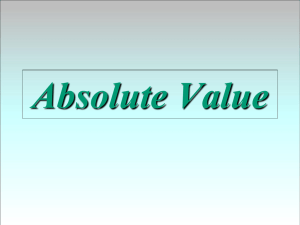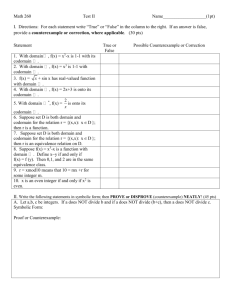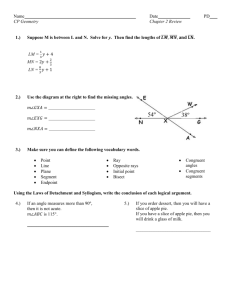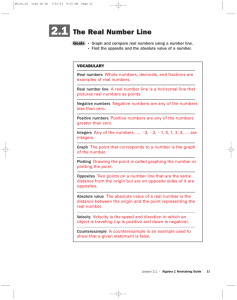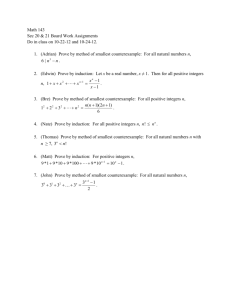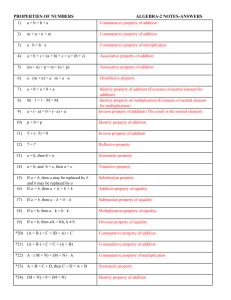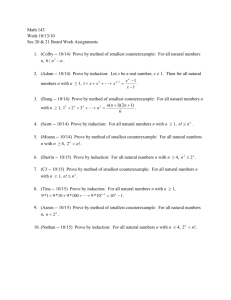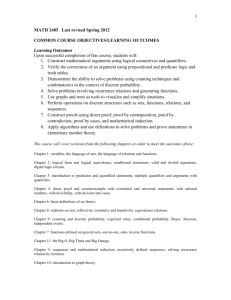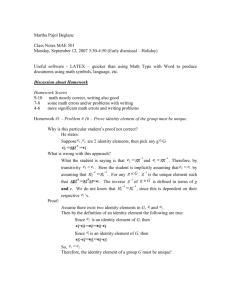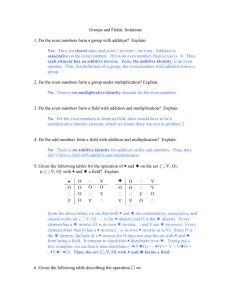Topic 1.4 Identity_Inverse_ClosureHW
advertisement
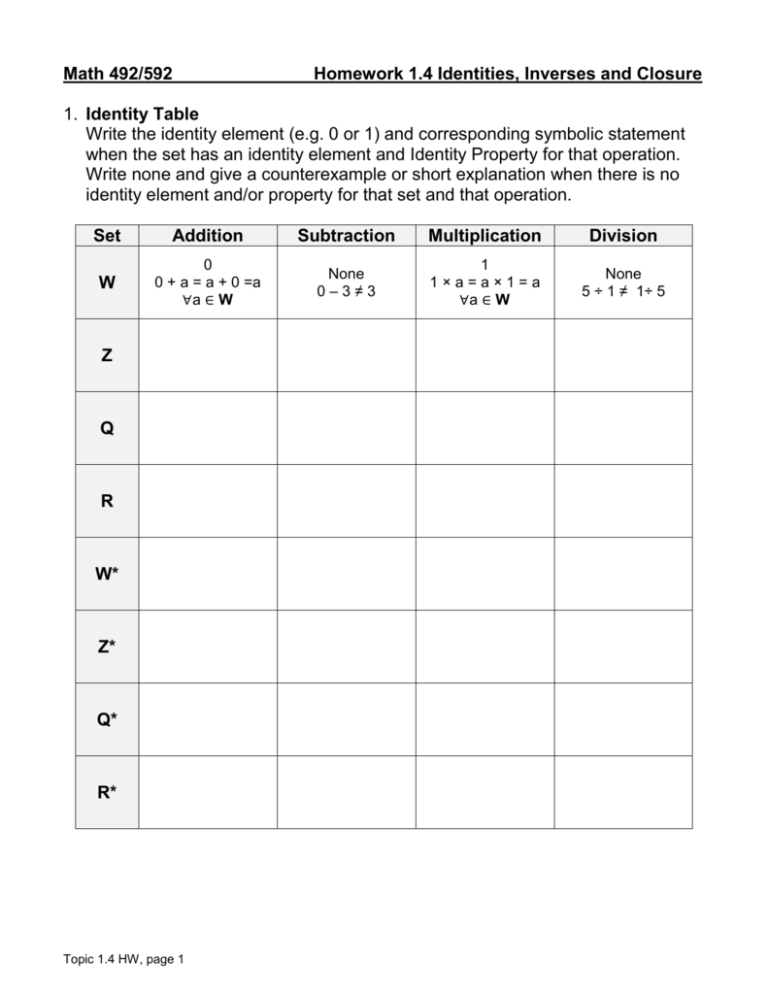
Math 492/592 Homework 1.4 Identities, Inverses and Closure 1. Identity Table Write the identity element (e.g. 0 or 1) and corresponding symbolic statement when the set has an identity element and Identity Property for that operation. Write none and give a counterexample or short explanation when there is no identity element and/or property for that set and that operation. Set Addition Subtraction Multiplication Division W 0 0 + a = a + 0 =a ∀a ∈ W None 0–3≠3 1 1×a=a×1=a ∀a ∈ W None 5 ÷ 1 ≠ 1÷ 5 Z Q R W* Z* Q* R* Topic 1.4 HW, page 1 2. Inverses Table Give the general “inverse element” and corresponding symbolic statement when the set has an Inverse Property for that operation. Write none and give a counterexample or brief explanation when there is no inverse property for that set and that operation. W is done as an example. Set Addition Subtraction Multiplication Division W None No -a ∈ W a a - a = a - a =0 ∀a ∈ W None, 0 has no inverse in W None 5 ÷ 1 = 5 but 1 ÷ 5 =1/5 ≠ 5 Z -a -a + a = a + -a =0 ∀a ∈ Z Q R W* Z* Q* R* Topic 1.4 HW, page 2 1/a 1/a×a = a×1/a =1 ∀a ∈ z 3. Closure Table Write “closed” and the corresponding symbolic statement when the set is closed with respect to that operation. Write “not closed” and give a counterexample or brief explanation when the set is not closed that operation. W is done as an example. Set Addition Subtraction Multiplication Division W Closed a+b∈W ∀a, b ∈ W Not closed 3 – 5 = -2 W Closed a×b∈W ∀∈W Not closed 1 ÷ 5 =1/5 W Z Q R W* Z* Q* R* Topic 1.4 HW, page 3 5. (Adapted from a 9th grade textbook.1) Assume Z is closed under multiplication and addition. a. Prove the set of rational numbers Q is closed under addition by completing the following. Fill in the five boxes and the blank. Step Let a and b be any rational numbers. We want to show a + b is in Q. a = p/q and b = r/s where p, q, r, s are in Z with q and s nonzero p r ab q s ps r qs s qs qs Justification Begin the proof. State the goal. By one of the definitions of rational numbers Substitution Find a common denominator Add the fractions qs The numerator and denominator of a + b are both integers and the denominator is not 0 because ____________________________________________________. Therefore, a + b is in Q. b. Write a similar proof to show Q is closed under multiplication. 1 On Core Mathematics: Grade 9, Houghton-Mifflin Harcourt 2013, Unit 1 Lesson 1 Topic 1.4 HW, page 4 6. Define the following new (weird but cool) operation # on Q. ∀ a, b Q, a # b = a + b + 4 a. Calculate (give answers as whole numbers or ratios of integers, but not as decimals). Follow order of operations and do the calculation inside the ( )s first. Show your work. i) 2 # 3 ii) 3 # 2 1 3 iii) # 2 7 3 1 iv) # # 4 7 2 v) 1 3 # # 4 2 7 For the following sets of symbolic statements and proofs (parts b – f): Don’t write in other operations (except for the +4) In every case, use a and b as your general rational numbers (that is start with “let a, b Q”) You can use properties of Q under + to justify proof steps b. Write the general symbolic statement for what it means to say Q has the Commutative Property for #. Does Q have the Commutative Property for #? Prove it symbolically or give a counterexample. c. Write the general symbolic statement for what it means to say Q has the Associative Property for #. Does Q have the Associative Property for #? Prove it symbolically or give a counterexample. d. Write the general symbolic statement for what it means to say Q has the Identity Property for #. Does Q have the Identity Property for #? Prove it symbolically or give a counterexample. Of course, you’ll have to give the Identity element for Q under # in this proof. e. Write the general symbolic statement for what it means to say Q has the Inverses Property for #. Does Q have the Inverses Property for the operation #? Prove it symbolically or give a counterexample. Of course, you’ll have to give the general form for the inverse element for a Q under # in this proof.) Topic 1.4 HW, page 5 f. Write the symbolic statement for what it means to say Q has the Closure Property for #. Does Q have the Closure Property for #? Prove it symbolically or give a counterexample. 7. Extend (reduce?) the following operation # to Q*. ∀ a, b Q*, a # b = a + b + 4 a. Is # commutative in Q*? Explain why or give a counterexample. b. Does Q* have the Identity property for #? Explain. c. Is Q* closed under #? Explain why or give a counterexample. Topic 1.4 HW, page 6
